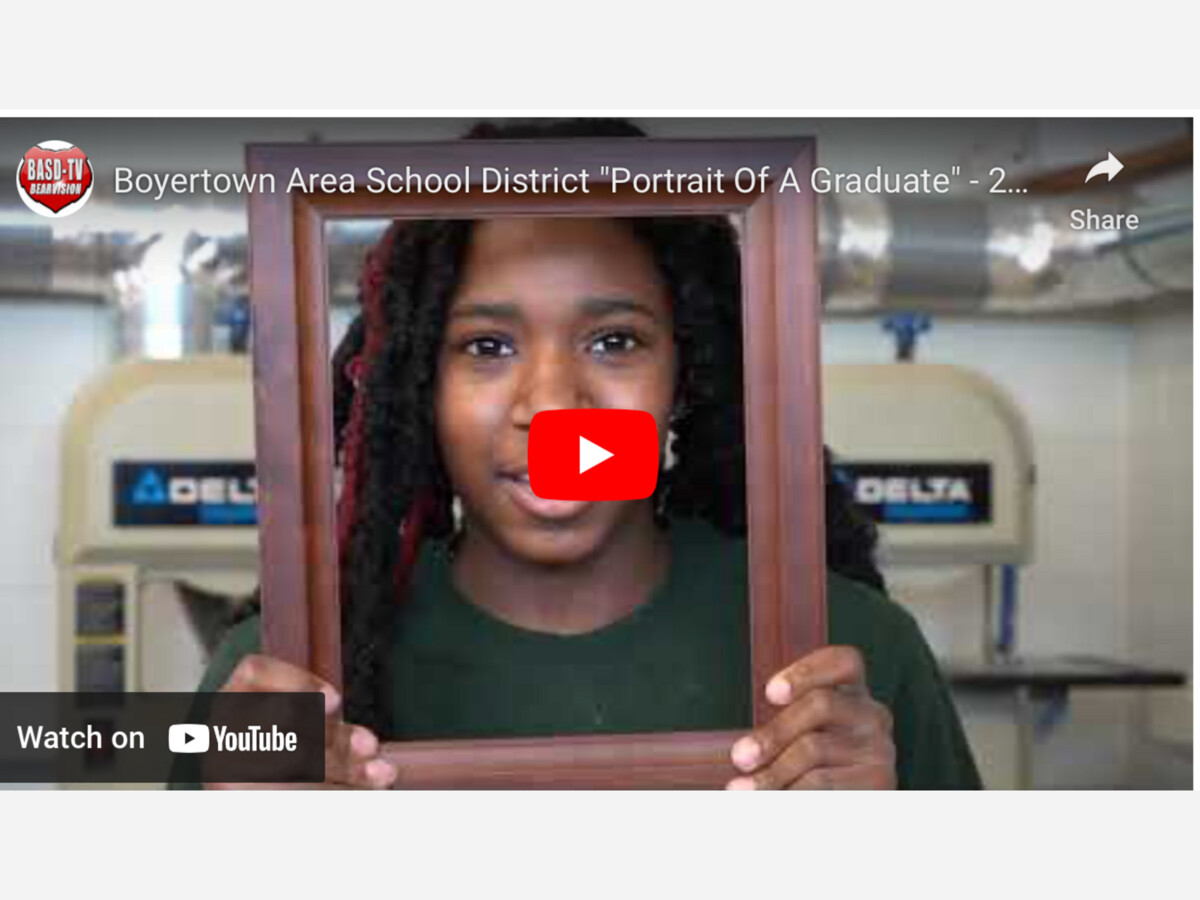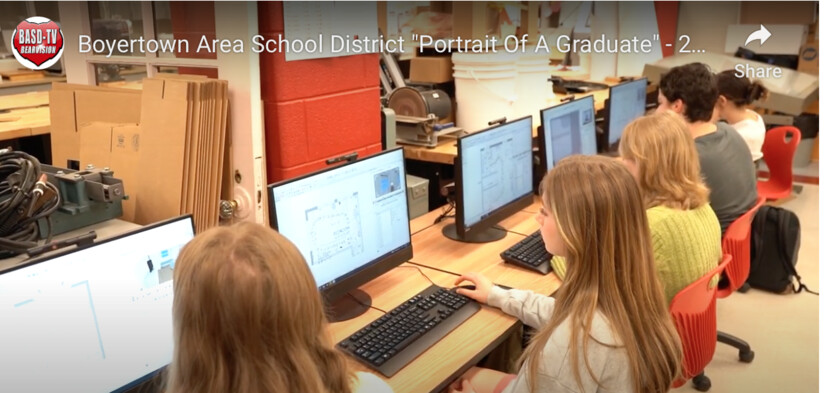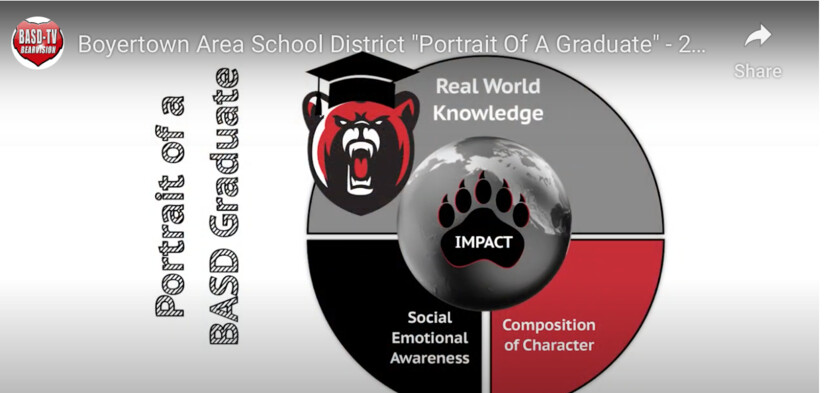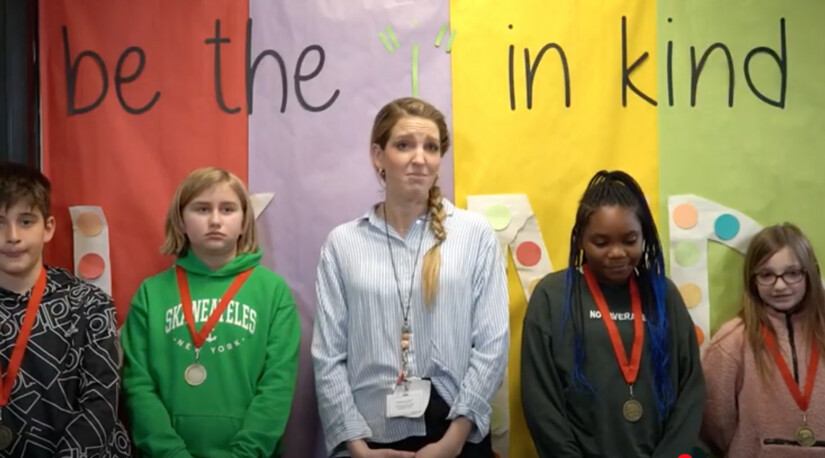Image


By Jane Stahl
Let Me Explain:
Although I have been retired for 17 years, my heart has never really left the classroom. After 35 years leading thousands of students in developing their communication skills in reading, writing, speaking, and studies of literature and language, I guess that’s not surprising.
So when I heard that the Back-to-School Welcoming Day for Boyertown School District’s teachers and staff featured an 8-minute video entitled “Portrait of a Graduate,” I was immediately intrigued and I eagerly requested to meet with members of the school district who had initiated the project and directed the process. What I learned surprised and impressed me.
I wondered: What would a graduate "look" like? What would they know? How would they behave? What would they want to do with their lives? What goals would they pursue? What values would they hold onto and demonstrate throughout their lives?
I also wondered about the process of deciding what qualities a Boyertown graduate should possess and how those qualities would be honed in their classes and activities throughout their 12+ years.
Added to my curiosity were concerns expressed widely about the state of American education—heightened by the COVID pandemic’s impact on student learning, development, and achievement. In March 2020, as the world locked down, within a weekend, teachers needed to re-invent teaching and learning using technology. Learning remotely had flipped teaching on its head.
But it would seem that “after the dust settled” and students were pursuing their curricula, the worldwide crisis had provided a perfect moment to release a clear picture of a Boyertown graduate.
Enlightened and Encouraged
I was enlightened and encouraged from my meeting with Sara Obarow, BASD’s Director of Teaching and Learning; Jennifer Joyce, Curriculum Supervisor for grades K-8; Rochelle Towne, Curriculum Supervisor for grades 6-12; and Alison Moyer, Communications Specialist.
The portrait, as they described it, was created from the results of conversations and surveys that were conducted with the stakeholders. Surveys were distributed to all teachers, students from grades 3-12, and their parents. Surveys were sent and responses collected through social media and the district website to help formulate a list of real-world knowledge, character traits, and behaviors that graduates would ideally demonstrate.
From the survey responses, a list of characteristics was created making sure students would have the skills and knowledge they’d need for all the changes they would experience—characteristics that offered flexible pathways to meet the interests, strengths, and individual goals—and would match the priorities the community determined would generate productive citizens capable of making a positive impact.
The list of characteristics included common characteristics, what employers are looking for, terms that were already demonstrated in successful students. The committee consulted resources offered by educational consulting groups and the Collaborative for Academic, Social and Emotional Learning (CASEL) to corroborate their direction. Problem solving and effective communication topped the list, and I recalled lessons in classes I taught where tips on giving and taking criticism, and negotiating conflicts, for example, were valued by my students and their parents and employers.
I wonder if we'd recognize present-day, tech-savvy students. Preparing them for the world of tomorrow-a world constantly changing, is a daunting task. Yet, schools are directed to prepare students who, as individuals, have their own unique goals and are constantly changing as well.
Current research suggests that students today have greater curiosity, are more open-minded, and are more adaptable. Many of them are not thinking of having a 30-year career anywhere. The gig economy is real, and the jobs they will hold are not yet invented. With this reality, students will need increased skills in problem-solving, enhanced adaptability and flexibility.

Beyond those characteristics, technology has changed young people; no longer is the information they’re exposed to filtered in any way. What happens in the world comes at them in real time and it’s constant. There’s no time, no delay to process a school shooting, for example, and there’s often no adult in the room to help them, to provide some protection or model informed behavior.
I recalled my own experiences with students after 9/11. When I met them the next morning--fresh from watching the Towers fall--I felt, as a credible adult in their lives, that I needed to help them process the horror of the attack, the fear, and the confusion about what it meant for their futures. I felt I needed to "make meaning" for them as well as for myself. Apparently, because information comes at them so fast and so often, having adults as filters is now too-little, too-late.
In addition, the information today's students consume is often not age-appropriate, and they’re caught off-guard without the emotional skills or fact-checking. They get information that is often false from people of all ages—often from their peers and from all over the world.
The ability to adapt to change of all kinds was tested in recent years in what can be seen as a “trifecta” or “perfect storm” of consequences: the pandemic, technology, and the predominance of unverified information. While change is forced on everyone—and change is tough for everyone—structure is welcomed as students have returned to their classrooms. And some of that structure may be a result of the clarification provided by the development of the Portrait of a Graduate.
From the research the model was developed and includes 3 separate aspects: content knowledge—representing 50% of the picture—the other 50% representing composition of a student’s character and social/emotional skills and development.

The content area described in the video includes a rigorous education in the traditional major subject areas plus foundational concepts involving digital literacy, career awareness, and financial literacy along with electives to personalize the learning experience based on interests, strengths, and goals.
The video explains that career awareness begins in the 2nd grade and is addressed by providing students with opportunities to participate in internships, organizing visits from veterans and visits to Berks Technology Center, for example. Writing skills, working independently and in small groups are included as part of career knowledge.


In the video the social/emotional area showcased includes development of self-knowledge, empathy, developing supportive relationships, team building, skills in working with others to support communities, and making good decisions. Examples of lessons in this area include participation in student advisory groups, enjoying nature during a visit to the park, and creating a bulletin board with fish of all different colors representing “you-be-you” diversity, but swimming in the same direction.


The video offers that the district's goals for character include traits of kindness, compassion, resilience, and integrity. Developing these traits are activities like designating student mentors to aid younger students in their transitions to a new grade or experience, assemblies featuring “student of the month” and/or graduates who have made a positive impact in some way in their communities.


The components of the district's goals are embedded in all instruction, activities, clubs, and organizations at all levels and go beyond what can be measured in testing.
I wonder if students' "greater curiosity," being more "open-minded" and "adaptable" makes them more or less willing to follow established school procedures, accept the leadership of their teachers and administrators, or conform to traditional approaches to learning.
The "Portrait of a Graduate" video presents an exciting learning environment. Teachers are charged with matching educational best practices to meet the needs of today's students' evolving styles. Preparing them for success in a complicated, changing world--the district's mission statement--is Job #1.
While it's too soon to tell whether the effort to create a “Portrait of a Graduate” has made a difference in students or their classrooms, let us hope that teachers will find a difference in their classrooms and in the hallways--students less stressed, more courteous.
The center of the model suggests that learning is all about "impact." The impact on students and the impact that students make on their worlds. From simply how they say "good morning" or "good night." Impact is the point.
Noting that the knowledge portion of the model is twice as important as the other areas, it is telling that the knowledge aspect of the portrait rests on a foundation of character development and social/emotional learning—without which, knowledge can be misused. Or abused.
In the end, developing the "Portrait of a Graduate" allowed all the stakeholders to explore the "why." Why we use our knowledge and skills. Exploring why teachers, for example, went into education is often inspirational, and kids need to know.
Mary Beth [Torchia, BASD’s superintendent], reportedly shared her own story of why she went into education that inspired new teachers to the district on their opening day.
When I taught, I shared a daily quote to help set the tone for the day; I encouraged teachers in media releases I created and in the reflective essays I assigned to my students to share their "why." I was always excited to celebrate all the positive stories happening in every classroom with each of our amazing kids.
I was impressed with the district’s initiative in determining the qualities and characteristics that a graduate of Boyertown Area School District should acquire, thinking of the adage, “If you don’t know where you’re going, you’ll probably end up somewhere else” and the third habit of Stephen Covey’s popular book Seven Habits of Highly Effective People: “Begin with the end in mind.”
Apparently, a PDE (Pennsylvania Department of Education) conference in Hershey provided the impetus for the project. The idea was triggered hearing about a model that Ephrata School District was employing. I'd first heard about the initiative from former school director Jill Dennin at a school board meeting that I attended, who heard about and liked the idea and suggested the school board consider exploring the effort.
BASD’s video “Portrait of a Graduate” is full of examples worthy of celebration and showcases students who would make Yogi Berra and Stephen Covey proud; they know exactly “where they’re going” and, more important, why.
And while I loved teaching and often miss the opportunity to work with young people, I am confident that Boyertown Area School District students are getting a solid education and on their way to becoming knowledgeable, active, productive, and caring people making their world a better place. Exactly what the world needs now.